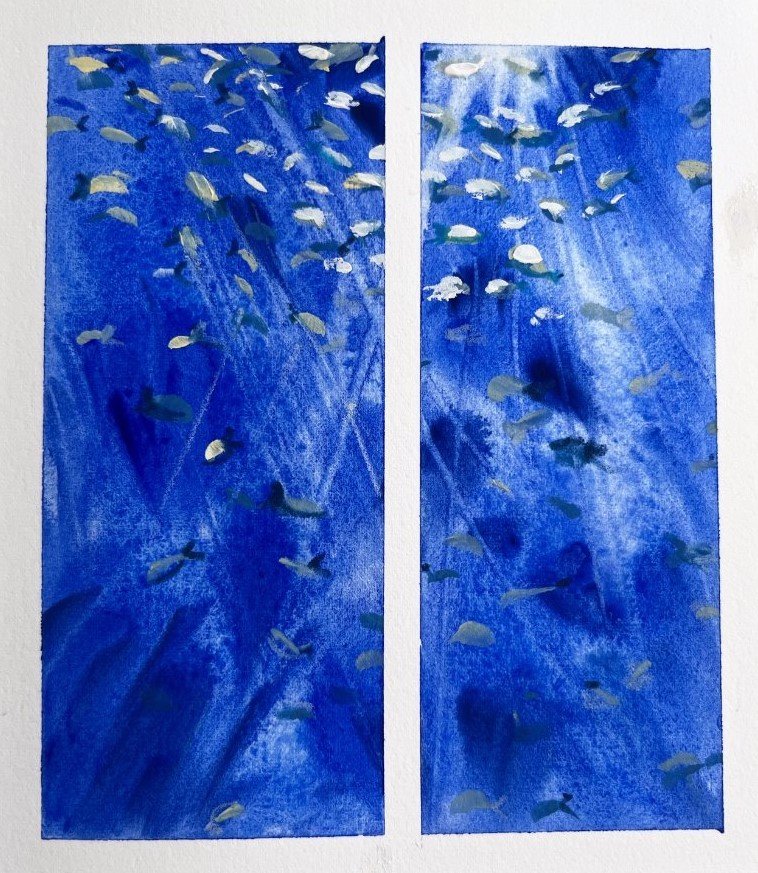5 Techniques I Use for Looser Painting
I find myself using a few different techniques to make looser marks, which in turn make for looser paintings. In the video below, I share 5 of these techniques and examples of those techniques in action as I flip through a week of sketchbook entries inspired by the color sapphire blue.
If you’re more a reader, I’ll list them out below for you with a bit of explanation:
Use A Variety of Strokes
When I’m painting, I vary my marks between long and short strokes, small and large dabs, and I change directions. Often times the stroke I’m making is mimicking a motion that I see in my reference or a feeling that I’m trying to portray. I find even if you are using one color, the density of the paint or water is affected by the way you are laying down the strokes and you can see a difference. I like to have fun with the way I use my brush and how it’s moving and I like to think that you can see that in the way the paint ends up laying on the page.
While painting this cloud scene, I used a series of short “fluffy” strokes as well as more drawn out linear ones to convey different parts of the sky
Vary Pressure and Roll
I’ve been playing quite a bit with Caran D’Ache NecolorII watersoluble wax pastels lately and discovered that dipping the pastel tip in water and then drawing can create some fun effects. Varying the pressure is one way to create a variety of line widths. But rolling while putting pressure on the pastel makes for even more interesting and looser marks.
The lines in the blue background were made using a wax pastel dipped in water and then rolled with varying pressure
Work Wet
Working wet is definitely a “go-to” way for me to keep things feeling more loose when I paint. And when I say working wet, I mean wetting large areas of the painting or the whole painting and working from a wet base while adding details as it dries over time. Painting wet allows for a lot of movement and motion. You can get unexpected results and it can be fun to let the water and paint take over and do it’s own thing.
Simplify Forms
Simplifying forms takes practice and is something I'm still working on getting better at. But what I do know, is that making decisions to not paint certain details while still conveying the subject or feeling always helps me create more looseness in my paintings.
I worked wet for the background and I simplified the fish from my reference image by representing them as dabs of color instead of fish
Get Globby and Streaky
This last technique I’m sharing applies specifically to gouache. Gouache, if you don’t happen to know, is a a more opaque form of watercolor. It can even be watered down and used more like watercolor but I like using it nice and thick. I find it very satisfying to use large globs of it with very little to no water and creating texture with visible brush stroke lines. The nice thing about gouache is that the opacity allows you to layer as you go so the outcome is quite different than watercolor. I also like to get different colors right on the brush and paint. It creates an element of surprise and variety that I wouldnt get by intentionally adding colors one at a time.
I’ve really globbed on the gouache paint here and mixed colors together directly on the brush for a streaky brushstrokes
I know I didn’t take a deep dive into any of these techniques, but I hope that seeing a few examples of how I incorporated these 5 techniques into my paintings will spark a bit of inspiration for you. Perhaps you already implement some or all of these techniques. If you have any techniques you find yourself turning to to keep your work feeling loose, I’d love to read about them in the comments below!
As always, thanks so much for reading and watching!
Susan





